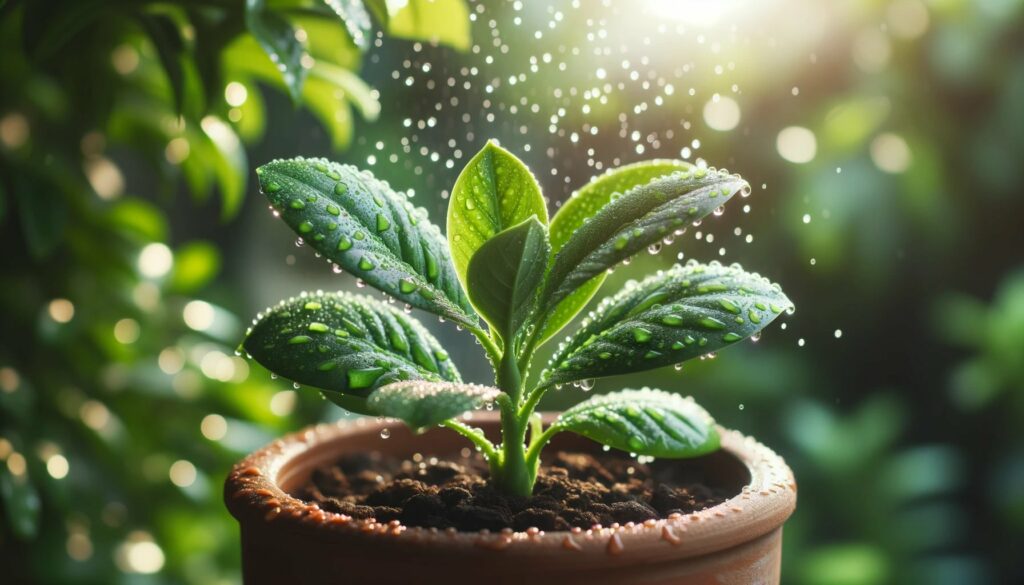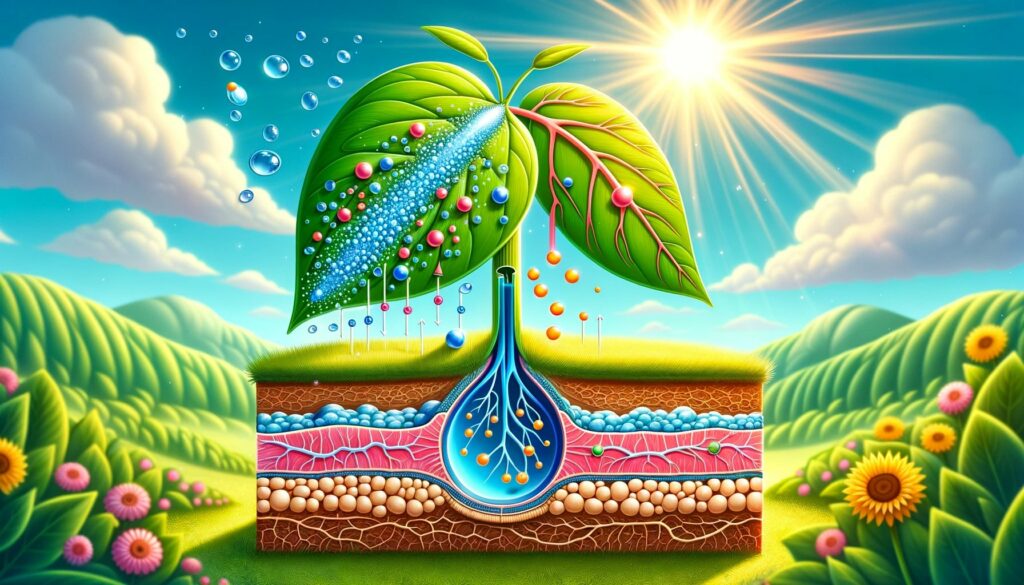Transpiration, a fundamental process in plant physiology, plays a crucial role in the uptake and distribution of water in plants. As plants breathe through tiny pores on their leaves, known as stomata, they release water vapor into the atmosphere. This seemingly simple act has profound implications for a plant’s survival and growth. In this article, we will explore the fascinating world of how transpiration enables plants to access and distribute water, uncovering the intricate mechanisms behind this vital process. Join us as we delve into the captivating realm where plants harness the power of transpiration to ensure their hydration needs are met.
How does transpiration provide water in plants?
Transpiration, a crucial process for plant survival, plays a significant role in providing water to plants. By understanding the intricate mechanisms involved in transpiration, we can unravel how plants uptake and distribute water. So, let’s dive into this fascinating world and explore how transpiration facilitates the water supply for plants.
Transpiration: The Basics
Transpiration, simply put, is the evaporation of water from the leaves of plants. It primarily occurs through tiny openings called stomata present on the leaf surface. When stomata open to allow the entry of carbon dioxide for photosynthesis, water on the surface of leaf cells evaporates and diffuses out of the leaf.
The Transpiration Stream: Uptake and Distribution of Water
Transpiration sets in motion a continuous stream of water, aptly named the transpiration stream. This stream involves water being drawn from the cells in the xylem, which is one of the plant’s conducting tissues. The water moves through the xylem vessels, from the roots to the leaves, driven by a tension or ‘pull’ created by transpiration in the leaves.
Due to the cohesive nature of water molecules, this ‘pull’ results in water being pulled up through the plant. Think of it as a chain-reaction, where water molecules cling together and create a continuous flow from the roots to the leaves.
The Role of Transpiration in Plant Water Uptake
So, how does transpiration provide essential water for plants? The answer lies in the transpiration stream. As water is pulled up through the plant, it fulfills several crucial functions:
1. Water Uptake: The transpiration stream ensures a steady supply of water from the roots to the leaves. This water uptake is vital for maintaining the overall moisture levels within the plant.
2. Water Turgor: The movement of water through the plant helps maintain the plant’s structure and stability. It ensures that plant cells remain turgid, helping them stand upright.
3. Nutrient Transportation: Transpiration is not limited to water alone. Along with water, dissolved mineral ions are also transported through the plant via the xylem vessels. This enables essential nutrients to reach different parts of the plant.
4. Photosynthesis Support: Leaves require an adequate water supply to carry out photosynthesis efficiently. The continuous transpiration stream ensures that leaves receive enough water for this crucial process.
5. Temperature Regulation: Transpiration provides an effective cooling mechanism for leaves, especially in warm temperatures. As water evaporates from leaf cells during transpiration, it helps cool down the leaves, preventing excessive heat build-up.
Factors Influencing Transpiration
Several factors affect the rate of transpiration in plants. These factors include:
- Temperature: Higher temperatures generally lead to increased transpiration rates.
- Humidity: Lower humidity levels result in faster transpiration, as the concentration gradient between the plant and the atmosphere enhances water loss.
- Wind: Increased air movement facilitates transpiration by carrying away water vapor from the leaf surface.
- Light Intensity: Higher light intensity often leads to greater transpiration rates due to increased stomatal opening for photosynthesis.
Understanding these influencing factors can help us comprehend how plants regulate transpiration under different environmental conditions.
Unraveling the Fascinating World of Transpiration
By exploring the intricate mechanisms of transpiration, we gain valuable insights into how plants use this process to uptake and distribute water. The transpiration stream, driven by evaporative water loss from leaves, supports vital functions such as water uptake, nutrient transportation, turgor maintenance, photosynthesis, and temperature regulation.
So, the next time you marvel at the wonders of nature, remember the incredible role that transpiration plays in providing essential water to plants, keeping them thriving and flourishing.
Transpiration is a crucial process in the water cycle that affects our everyday lives. Want to learn more about how plants release water vapor into the atmosphere? Explore the fascinating relationship between transpiration and the water cycle by clicking here. You’ll be amazed by the intricate mechanisms that drive this essential natural phenomenon!
The Process of Transpiration and How It Facilitates Water Movement Within Plants
Transpiration, the process of water movement through a plant and its evaporation from aerial parts, plays a vital role in providing water for plants. By understanding this process, we can unravel the intricate mechanisms behind how plants control their water balance.
How Does Transpiration Work?
Transpiration begins with the absorption of water by the root hairs. This water is then transported upwards through specialized tissue called xylem. Xylem serves as the conduit, or “plumbing system,” for water movement within plants. Eventually, the water reaches the leaves, where it is released through tiny openings called stomata.
The process of transpiration provides numerous benefits for plants. Firstly, it facilitates evaporative cooling, helping to regulate leaf temperature and prevent overheating. This is particularly important in warm environments. Additionally, transpiration allows for the entry of carbon dioxide, which is essential for photosynthesis, the process by which plants convert sunlight into energy. Transpiration also enables the absorption of nutrients from the soil and helps maintain the structure and stability of plants.
The Driving Forces Behind Transpiration
Transpiration occurs due to a water potential gradient between the soil and the atmosphere. Essentially, the atmosphere has a lower water potential compared to the soil, creating a “pull” that drives water upward through the plant. This gradient, coupled with the resistances to water movement within the plant, such as the narrow channels of the xylem, sets in motion a continuous flow of water known as the transpiration stream.
Types of Transpiration
There are three main types of transpiration: stomatal transpiration, cuticular transpiration, and lenticular transpiration. Stomatal transpiration occurs through the stomata on the leaf surface, which open and close to regulate water loss. Cuticular transpiration happens through the waxy cuticle that covers leaves, while lenticular transpiration occurs through openings called lenticels in woody stems. Each type contributes to the overall water loss of the plant.
Measuring Transpiration
Scientists employ various techniques to measure transpiration rates accurately. The gravimetric method involves measuring the weight loss of a potted plant over a period of time due to water evaporation. The porometer method measures stomatal conductance, providing insight into the plant’s water loss through its stomata. Another technique, sap flow measurement, evaluates the flow of sap in the xylem, reflecting the rate of water movement within the plant.
The Impact of Transpiration on Climate
Transpiration is not just crucial for individual plants but also influences the larger climate system. As plants transpire, water vapor is released into the atmosphere. This contributes to the water cycle, where water is absorbed from the soil, moves through the plant, and returns to the atmosphere as water vapor. Consequently, transpiration plays a crucial role in regulating humidity levels and precipitation patterns.
Understanding the Fascinating World of Transpiration
In summary, transpiration is a fascinating process that enables plants to uptake and distribute water effectively. By driving water movement through the plant, transpiration supports vital functions such as photosynthesis, nutrient transportation, and maintaining plant structure. It also helps cool the leaves and contributes to the water cycle, influencing the broader climate system.
By delving into the world of transpiration, we gain valuable insights into the intricate mechanisms behind plant water uptake and distribution. This knowledge holds great significance as we strive to support the growth and survival of plants in various environments.
Factors influencing transpiration rates and their effects on plant water availability
Transpiration, the loss of water vapor through plant stomata, plays a vital role in providing water for plants. It is influenced by various factors that ultimately affect the availability of water to plants. Understanding these factors is crucial for comprehending how plants use transpiration to uptake and distribute water, supporting their growth and survival.
Environmental Factors and Transpiration Rates
Environmental factors such as temperature, humidity, air movement, and light intensity significantly impact the rate of transpiration. In hot, dry, and windy conditions, the rate of transpiration increases. When the temperature rises, the evaporation rate of water from the leaves also increases. Additionally, low humidity and air movement promote faster transpiration rates. The intensity of light also affects transpiration, as plants tend to have higher rates in brighter light conditions.
The Relationship Between Water Loss and Plant Water Availability
It is fascinating to note that while transpiration facilitates water exchange and uptake for plant growth, less than 1% of the water reaching the leaves is used in photosynthesis and plant growth. Most of it is lost through transpiration. This process allows plants to regulate their temperature and facilitate the entry of carbon dioxide for photosynthesis. However, excessive water loss through transpiration can pose a challenge in maintaining adequate water availability for plants.
Root Length Density and Water Availability
Another crucial factor affecting plant water availability is root length density. Root systems with higher density will have access to more water, while sparse root systems may face limitations in water uptake. The density of roots within the soil plays a significant role in determining the ability of plants to extract water from the surrounding environment. Hence, root length density is an important parameter that affects water availability and, consequently, plant growth.
Stomatal Behavior and Environmental Conditions
Plants have the ability to regulate their stomata, small pores present on the surface of leaves, to reduce water loss by transpiration. Stomata can open and close to control the transpiration rate based on environmental conditions. When temperatures are high and humidity is low, plants can close their stomata to minimize water loss. By doing so, they maintain better control over their water balance and ensure that sufficient water is available for essential physiological processes.
Table: Summary of Factors Affecting Transpiration Rates
| Environmental Factor | Effect on Transpiration Rate |
|---|---|
| Temperature | Higher temperature increases transpiration |
| Humidity | Low humidity increases transpiration |
| Air movement | Windy conditions increase transpiration |
| Light intensity | Bright light promotes higher transpiration |
| Root Length Density | Higher density increases water availability |
Understanding the factors that influence transpiration rates provides insights into how plants regulate their water balance. By adapting their behavior based on environmental conditions, plants can ensure that they have access to sufficient water for growth and survival. However, it is crucial to strike a balance between transpiration rates and water availability to prevent water stress and support optimal plant productivity.
In conclusion, the factors influencing transpiration rates and their effects on plant water availability are complex and interrelated. Environmental conditions, root length density, and stomatal behavior all play critical roles in determining the rate of water loss through transpiration and the subsequent availability of water for plants. By unraveling these intricate mechanisms, we can better comprehend the fascinating world of how plants use transpiration to uptake and distribute water, ultimately supporting their growth and survival.
Now, let’s explore the detailed aspects of these factors and their effects on plant water availability.
FAQ
Q: What is transpiration and how does it provide water for plants?
A: Transpiration is the process by which water is drawn from the cells in the xylem to replace that which has been lost from the leaves. Water moves through the xylem vessels in a continuous transpiration stream from the roots to the leaves. This process produces a tension or ‘pull’ on the water in the xylem vessels by the leaves, allowing water to be pulled up through the plant and distributed to all its parts.
Q: How does transpiration affect plant hydration and water distribution?
A: Transpiration plays a vital role in maintaining plant hydration and facilitating water distribution. When a plant opens its stomata to let in carbon dioxide for photosynthesis, water on the surface of the cells in the spongy mesophyll and palisade mesophyll evaporates and diffuses out of the leaf. This loss of water creates a transpiration stream, ensuring that water is transported from the root to the leaf. Additionally, transpiration helps in the movement of mineral ions, maintains plant structure through water turgor, and aids in evaporative cooling of leaves.
Q: What factors can influence the rate of transpiration in plants?
A: Several environmental factors can affect the rate of transpiration in plants, including temperature, humidity, wind, and light intensity. Hot, dry, and windy conditions can increase transpiration rates, while cooler temperatures, high humidity, and low light intensity may decrease transpiration. These factors influence the water potential gradient from the soil to the atmosphere and the resistances to water movement through the plant, thus impacting the overall rate of transpiration.
Q: How is transpiration measured in plants?
A: Transpiration can be measured using different techniques. Some common methods include the gravimetric method, where the weight loss of a plant is measured; the porometer method, which measures stomatal conductance; and sap flow measurement, which quantifies the flow of sap through the xylem. These techniques provide valuable insights into the rate at which water is being transpired by a plant.
Q: What is the significance of transpiration in the global water cycle?
A: Transpiration plays a crucial role in the global water cycle. It contributes to the movement of water from the soil into plants and eventually to the atmosphere as water vapor. It is estimated that transpiration in higher plants accounts for approximately three-quarters of the water vaporized at the global land surface and one-eighth of the total water vaporized worldwide. Water availability, facilitated by transpiration, is vital for terrestrial plant production and maintaining moisture conditions in the environment.
- China II Review: Delicious Food & Speedy Service - April 17, 2025
- Understand Virginia’s Flag: History & Debate - April 17, 2025
- Explore Long Island’s Map: Unique Regions & Insights - April 17, 2025



















